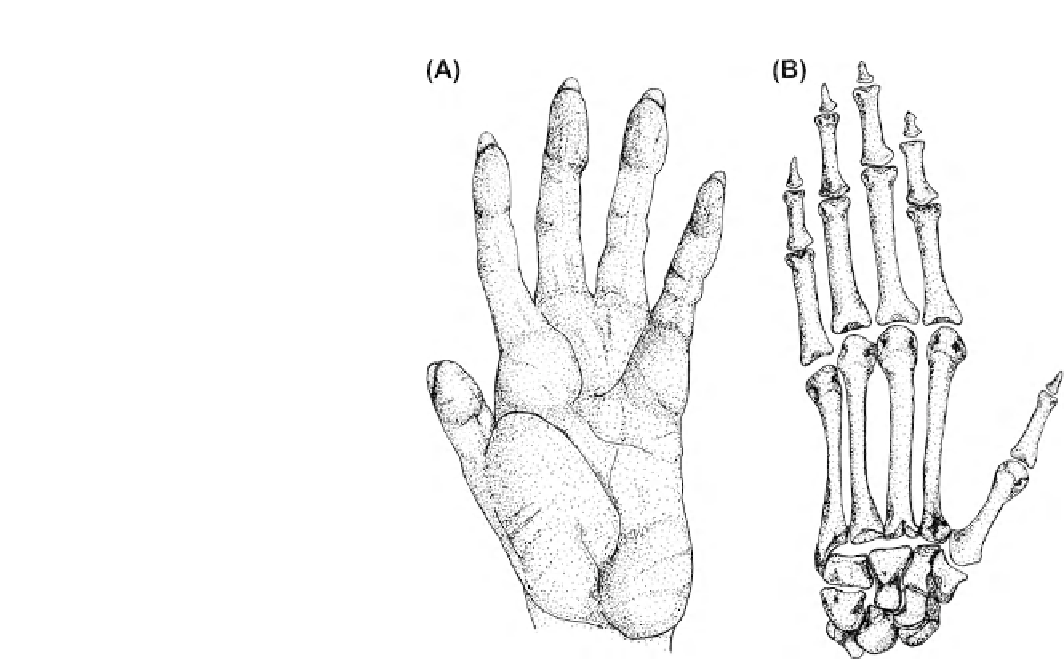Biomedical Engineering Reference
In-Depth Information
FIGURE 4.3
Morphology of the left hand of
Macaca mulatta. (A) Palmar surface; (B) dorsal view
of the skeletal elements. Note the presence of a single
palmar pad with creases and dermatoglyphs. The major
creases reflect the functional divisions of the digits. The
nails on the digits are located dorsally but are visible
from the palmar (volar) view as they project beyond the
tips of the digits. In the skeleton, note the separation
between the first and second metacarpals. In the carpus,
the pisiform lies ventral (volar) to the proximal carpal
row and the lunate and os centrale are in very close
approximation. (Drawings by Nancy Hong.)
The only part of the primate body with extensive
voluntary muscular control over skin mobility is the head
and neck region with its emphasis on the muscles of facial
expression, mimetic musculature. The wide range of facial
expressions found among nonhuman primates has been
extensively studied for its role in social communication.
Marked similarities between some facial expressions in all
species of primates exist and signals made by one species
(including humans) can be clearly interpreted by another.
Voluntary skin mobility of parts of the body other than the
head and neck is very limited in nonhuman primates with
the exception of the insertion of a few muscle fibers into the
skin over
HEAD AND NECK MORPHOLOGY
Superficial Musculature
The muscles of facial expression, mimetic musculature, are
prominent features of nonhuman primates (
Huber, 1933;
Burrows et al., 2006, 2009
). These muscles, inserting into
the dermis surrounding various openings of the face, alter
the size and shape of those openings to produce the variety
of movements of the skin of the eyelids, lips, ears, neck,
and nostrils critical for interanimal signaling within the
context of the social organization. Visual displays, as well
as vocal repertoires, are essential to communicate every-
thing from threats and aggression to unease or sexual
solicitation. Examples of such visual displays are widening
of the eyes, raising the brow to expose the upper eyelid,
grimacing, lip smacking, and gaping. They also facilitate
movement of vibrissae (
Burrows et al., 2006
). As in
humans, these muscles are innervated by the motor
branches of the facial nerve (cranial nerve VII).
the lower
thoracic and abdominal
regions
(m. panniculus carnosus).
Nails or Claws
All Cebidae, Cercopithecoidea, and Hominoidea have nails
on the dorsum of the distal phalanges of all digits on the
hands and feet. The structure of these nails and the shape of
the distal phalanges in nonhuman primates are similar to
that described for humans. The Callitrichidae differ by
having nails only on the big toes (halluces) with claws on
the other 18 digits. However, these claws are more nail-like
than a typical mammalian claw in that they have a relatively
thin deep layer and the underlying distal phalanges are only
moderately clawshaped (
Soligo and M¨ ller, 1999
).
Ear
The external ears of primates are positioned laterally on the
head. The pinna varies in size from one species to another
but is generally small relative to head size. There is inter-
specific variability in the shape of the external ear but
usually it
is oval with some infoldings (
Bast, 1933;



